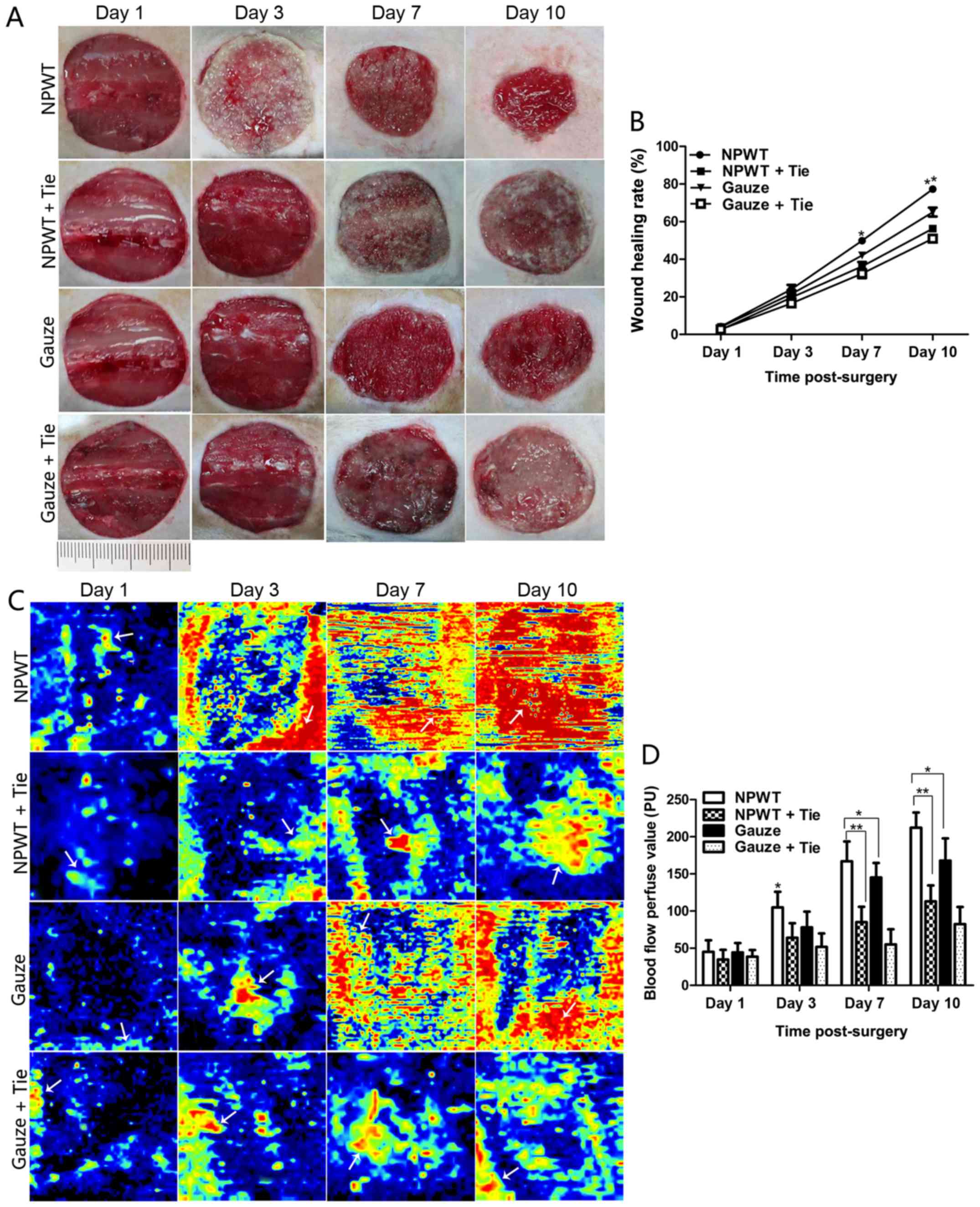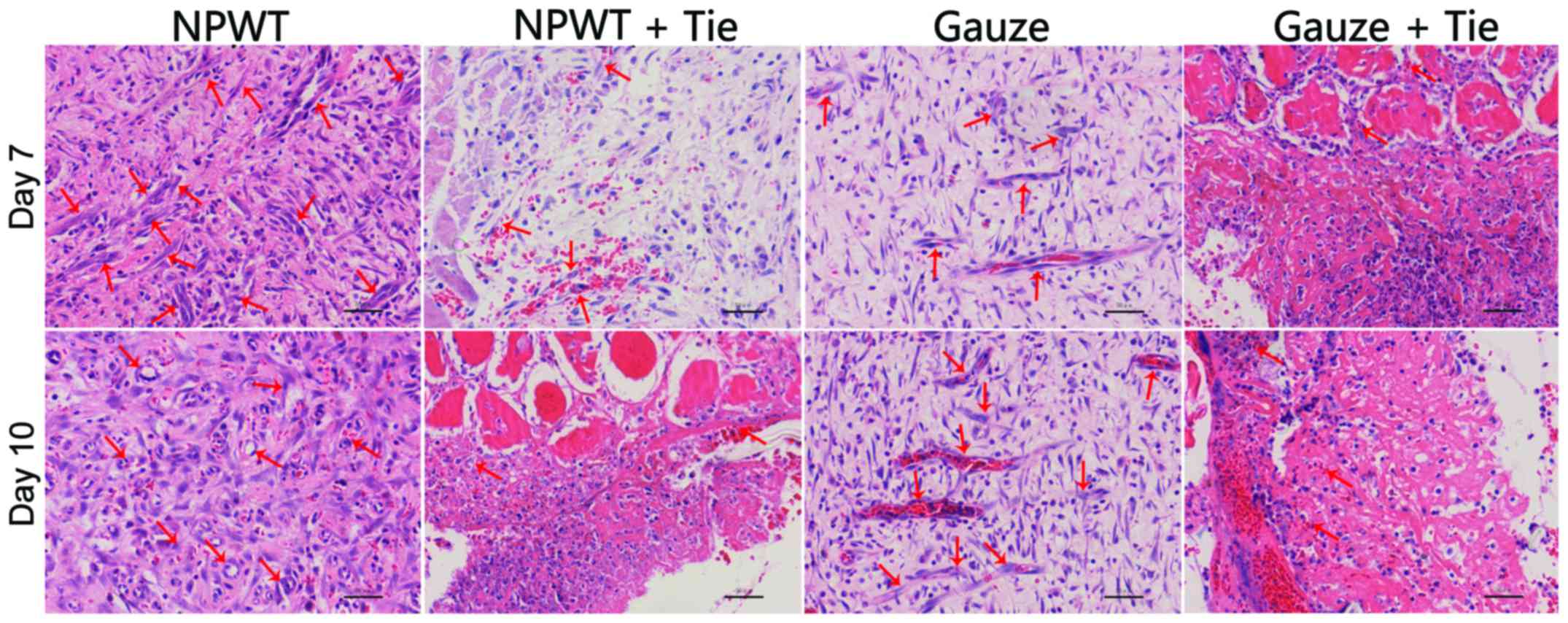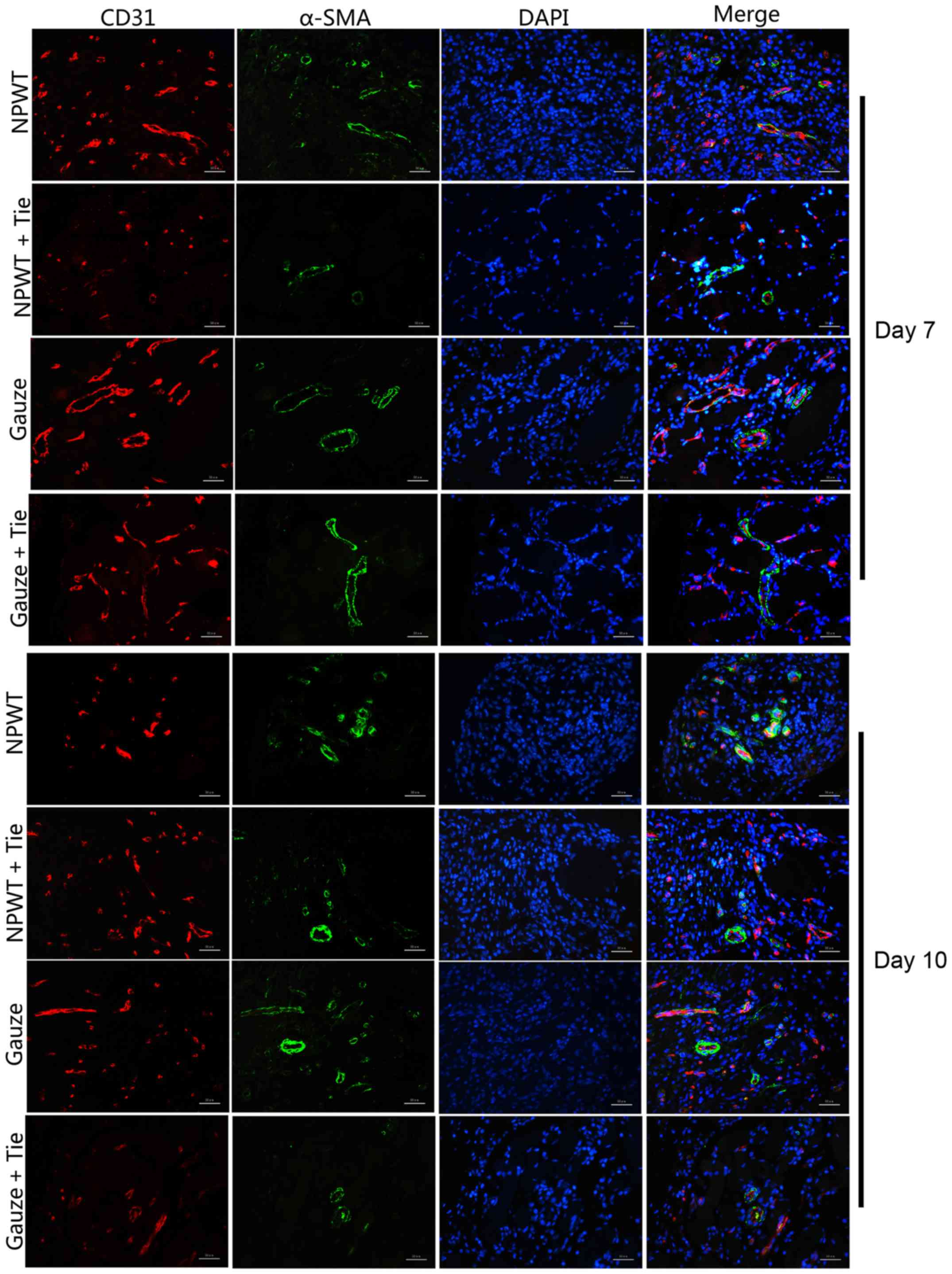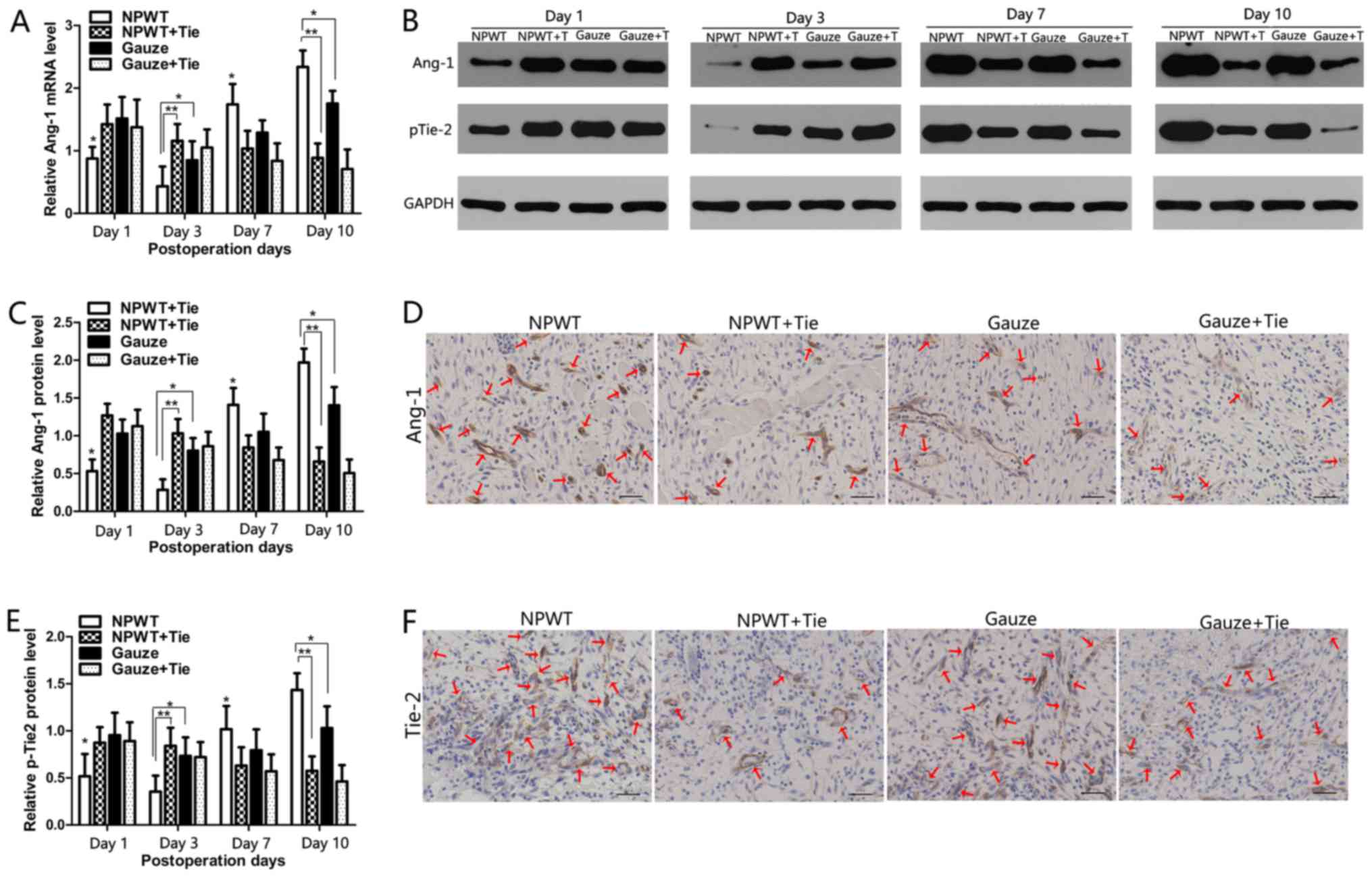|
1
|
Morykwas MJ, Argenta LC, Shelton-Brown EI
and McGuirt W: Vacuum-assisted closure: a new method for wound
control and treatment: animal studies and basic foundation. Ann
Plast Surg. 38:553–562. 1997. View Article : Google Scholar : PubMed/NCBI
|
|
2
|
Timmers MS, Le Cessie S, Banwell P and
Jukema GN: The effects of varying degrees of pressure delivered by
negative-pressure wound therapy on skin perfusion. Ann Plast Surg.
55:665–671. 2005. View Article : Google Scholar : PubMed/NCBI
|
|
3
|
Li X, Liu J, Liu Y, Hu X, Dong M, Wang H
and Hu D: Negative pressure wound therapy accelerates rats diabetic
wound by promoting agenesis. Int J Clin Exp Med. 8:3506–3513.
2015.PubMed/NCBI
|
|
4
|
Erba P, Ogawa R, Ackermann M, Adini A,
Miele LF, Dastouri P, Helm D, Mentzer SJ, D'Amato RJ, Murphy GF, et
al: Angiogenesis in wounds treated by microdeformational wound
therapy. Ann Surg. 253:402–409. 2011. View Article : Google Scholar : PubMed/NCBI
|
|
5
|
Orgill DP and Bayer LR: Negative pressure
wound therapy: Past, present and future. Int Wound J. 10(Suppl 1):
15–19. 2013. View Article : Google Scholar : PubMed/NCBI
|
|
6
|
Morykwas MJ, Simpson J, Punger K, Argenta
A, Kremers L and Argenta J: Vacuum-assisted closure: State of basic
research and physiologic foundation. Plast Reconstr Surg.
117(Suppl): 121S–126S. 2006. View Article : Google Scholar : PubMed/NCBI
|
|
7
|
Chen SZ, Li J, Li XY and Xu LS: Effects of
vacuum-assisted closure on wound microcirculation: an experimental
study. Asian J Surg. 28:211–217. 2005. View Article : Google Scholar : PubMed/NCBI
|
|
8
|
Wackenfors A, Sjögren J, Gustafsson R,
Algotsson L, Ingemansson R and Malmsjö M: Effects of
vacuum-assisted closure therapy on inguinal wound edge
microvascular blood flow. Wound Repair Regen. 12:600–606. 2004.
View Article : Google Scholar : PubMed/NCBI
|
|
9
|
Saxena V, Hwang CW, Huang S, Eichbaum Q,
Ingber D and Orgill DP: Vacuum-assisted closure: microdeformations
of wounds and cell proliferation. Plast Reconstr Surg.
114:1086–1098. 2004. View Article : Google Scholar : PubMed/NCBI
|
|
10
|
Xia CY, Yu AX, Qi B, Zhou M, Li ZH and
Wang WY: Analysis of blood flow and local expression of
angiogenesis associated growth factors in infected wounds treated
with negative pressure wound therapy. Mol Med Rep. 9:1749–1754.
2014. View Article : Google Scholar : PubMed/NCBI
|
|
11
|
Kairinos N, McKune A, Solomons M, Hudson
DA and Kahn D: The flaws of laser Doppler in negative-pressure
wound therapy research. Wound Repair Regen. 22:424–429. 2014.
View Article : Google Scholar : PubMed/NCBI
|
|
12
|
Lindstedt S, Malmsjö M, Hlebowicz J and
Ingemansson R: Comparative study of the microvascular blood flow in
the intestinal wall, wound contraction and fluid evacuation during
negative pressure wound therapy in laparostomy using the V.A.C.
abdominal dressing and the ABThera open abdomen negative pressure
therapy system. Int Wound J. 12:83–88. 2015. View Article : Google Scholar
|
|
13
|
Ashokkumar N and Pari L: Effect of
N-benzoyl-D-phenylalanine and metformin on carbohydrate metabolic
enzymes in neonatal streptozotocin diabetic rats. Clin Chim Acta.
351:105–113. 2005. View Article : Google Scholar
|
|
14
|
Hasenstein JR, Kasmerchak K, Buehler D,
Hafez GR, Cleary K, Moody JS and Kozak KR: Efficacy of Tie2
receptor antagonism in angiosarcoma. Neoplasia. 14:131–140. 2012.
View Article : Google Scholar : PubMed/NCBI
|
|
15
|
Lindgren M, Malmqvist LA, Sjöberg F and Ek
AC: Altered skin blood perfusion in areas with non blanchable
erythema: An explorative study. Int Wound J. 3:215–223. 2006.
View Article : Google Scholar : PubMed/NCBI
|
|
16
|
Weidner N: Tumoural vascularity as a
prognostic factor in cancer patients: The evidence continues to
grow. J Pathol. 184:119–122. 1998. View Article : Google Scholar : PubMed/NCBI
|
|
17
|
Uemura A, Ogawa M, Hirashima M, Fujiwara
T, Koyama S, Takagi H, Honda Y, Wiegand SJ, Yancopoulos GD and
Nishikawa S: Recombinant angiopoietin-1 restores higher-order
architecture of growing blood vessels in mice in the absence of
mural cells. J Clin Invest. 110:1619–1628. 2002. View Article : Google Scholar : PubMed/NCBI
|
|
18
|
Eberhard A, Kahlert S, Goede V, Hemmerlein
B, Plate KH and Augustin HG: Heterogeneity of angiogenesis and
blood vessel maturation in human tumors: Implications for
antiangiogenic tumor therapies. Cancer Res. 60:1388–1393.
2000.PubMed/NCBI
|
|
19
|
Goede V, Schmidt T, Kimmina S, Kozian D
and Augustin HG: Analysis of blood vessel maturation processes
during cyclic ovarian angiogenesis. Lab Invest. 78:1385–1394.
1998.PubMed/NCBI
|
|
20
|
Zhao J, Chen L, Shu B, Tang J, Zhang L,
Xie J, Qi S and Xu Y: Granulocyte/macrophage colony-stimulating
factor influences angiogenesis by regulating the coordinated
expression of VEGF and the Ang/Tie system. PLoS One. 9:e926912014.
View Article : Google Scholar : PubMed/NCBI
|
|
21
|
Glass GE, Murphy GF, Esmaeili A, Lai LM
and Nanchahal J: Systematic review of molecular mechanism of action
of negative-pressure wound therapy. Br J Surg. 101:1627–1636. 2014.
View Article : Google Scholar : PubMed/NCBI
|
|
22
|
Dumville JC, Hinchliffe RJ, Cullum N, Game
F, Stubbs N, Sweeting M and Peinemann F: Negative pressure wound
therapy for treating foot wounds in people with diabetes mellitus.
Cochrane Database Syst Rev. 10:CD0103182013.
|
|
23
|
Gaengel K, Genové G, Armulik A and
Betsholtz C: Endothelial-mural cell signaling in vascular
development and angiogenesis. Arterioscler Thromb Vasc Biol.
29:630–638. 2009. View Article : Google Scholar : PubMed/NCBI
|
|
24
|
Armulik A, Genové G and Betsholtz C:
Pericytes: Developmental, physiological, and pathological
perspectives, problems, and promises. Dev Cell. 21:193–215. 2011.
View Article : Google Scholar : PubMed/NCBI
|
|
25
|
Kim KE, Cho CH, Kim HZ, Baluk P, McDonald
DM and Koh GY: In vivo actions of angiopoietins on quiescent and
remodeling blood and lymphatic vessels in mouse airways and skin.
Arterioscler Thromb Vasc Biol. 27:564–570. 2007. View Article : Google Scholar
|
|
26
|
Holash J, Wiegand SJ and Yancopoulos GD:
New model of tumor angiogenesis: Dynamic balance between vessel
regression and growth mediated by angiopoietins and VEGF. Oncogene.
18:5356–5362. 1999. View Article : Google Scholar : PubMed/NCBI
|
|
27
|
Chantrain CF, Henriet P, Jodele S, Emonard
H, Feron O, Courtoy PJ, DeClerck YA and Marbaix E: Mechanisms of
pericyte recruitment in tumour angiogenesis: A new role for
metalloproteinases. Eur J Cancer. 42:310–318. 2006. View Article : Google Scholar : PubMed/NCBI
|
|
28
|
Kutcher ME and Herman IM: The pericyte:
Cellular regulator of microvascular blood flow. Microvasc Res.
77:235–246. 2009. View Article : Google Scholar : PubMed/NCBI
|
|
29
|
Hall CN, Reynell C, Gesslein B, Hamilton
NB, Mishra A, Sutherland BA, O'Farrell FM, Buchan AM, Lauritzen M
and Attwell D: Capillary pericytes regulate cerebral blood flow in
health and disease. Nature. 508:55–60. 2014. View Article : Google Scholar : PubMed/NCBI
|
|
30
|
Attwell D, Buchan AM, Charpak S, Lauritzen
M, Macvicar BA and Newman EA: Glial and neuronal control of brain
blood flow. Nature. 468:232–243. 2010. View Article : Google Scholar : PubMed/NCBI
|
|
31
|
Hamilton NB, Attwell D and Hall CN:
Pericyte-mediated regulation of capillary diameter: A component of
neurovascular coupling in health and disease. Front
Neuroenergetics. 2:22010. View Article : Google Scholar
|
|
32
|
Peppiatt CM, Howarth C, Mobbs P and
Attwell D: Bidirectional control of CNS capillary diameter by
pericytes. Nature. 443:700–704. 2006. View Article : Google Scholar : PubMed/NCBI
|
|
33
|
Puro DG: Physiology and pathobiology of
the pericyte-containing retinal microvasculature: New developments.
Microcirculation. 14:1–10. 2007. View Article : Google Scholar : PubMed/NCBI
|
|
34
|
Hellström M, Kalén M, Lindahl P, Abramsson
A and Betsholtz C: Role of PDGF-B and PDGFR-beta in recruitment of
vascular smooth muscle cells and pericytes during embryonic blood
vessel formation in the mouse. Development. 126:3047–3055.
1999.PubMed/NCBI
|
|
35
|
Ohlsson R, Falck P, Hellström M, Lindahl
P, Boström H, Franklin G, Ahrlund-Richter L, Pollard J, Soriano P
and Betsholtz C: PDGFB regulates the development of the
labyrinthine layer of the mouse fetal placenta. Dev Biol.
212:124–136. 1999. View Article : Google Scholar : PubMed/NCBI
|
|
36
|
Jespersen SN and Østergaard L: The roles
of cerebral blood flow, capillary transit time heterogeneity, and
oxygen tension in brain oxygenation and metabolism. J Cereb Blood
Flow Metab. 32:264–277. 2012. View Article : Google Scholar :
|
|
37
|
Kim PJ, Attinger CE, Steinberg JS and
Evans KK: Negative pressure wound therapy with instillation: Past,
present, and future. Surg Technol Int. 26:51–56. 2015.PubMed/NCBI
|
|
38
|
Benjamin LE, Golijanin D, Itin A, Pode D
and Keshet E: Selective ablation of immature blood vessels in
established human tumors follows vascular endothelial growth factor
withdrawal. J Clin Invest. 103:159–165. 1999. View Article : Google Scholar : PubMed/NCBI
|
|
39
|
Rivera LB and Brekken RA: SPARC promotes
pericyte recruitment via inhibition of endoglin-dependent TGF-β1
activity. J Cell Biol. 193:1305–1319. 2011. View Article : Google Scholar : PubMed/NCBI
|
|
40
|
Stratman AN, Malotte KM, Mahan RD, Davis
MJ and Davis GE: Pericyte recruitment during vasculogenic tube
assembly stimulates endothelial basement membrane matrix formation.
Blood. 114:5091–5101. 2009. View Article : Google Scholar : PubMed/NCBI
|
|
41
|
Stratman AN, Schwindt AE, Malotte KM and
Davis GE: Endothelial-derived PDGF-BB and HB-EGF coordinately
regulate pericyte recruitment during vasculogenic tube assembly and
stabilization. Blood. 116:4720–4730. 2010. View Article : Google Scholar : PubMed/NCBI
|
|
42
|
Yousif LF, Di Russo J and Sorokin L:
Laminin isoforms in endothelial and perivascular basement
membranes. Cell Adhes Migr. 7:101–110. 2013. View Article : Google Scholar
|
|
43
|
Tahajjodi SS, Amerion M, Mahdavi Shahri N,
Jalali M and Nikravesh MR: The effect of maternal nicotine on
basement membrane collagen IV of brain microvessels changes in
neonatal Balb/C mice. Iran J Reprod Med. 12:275–280.
2014.PubMed/NCBI
|
|
44
|
Senger DR and Davis GE: Angiogenesis. Cold
Spring Harb Perspect Biol. 3:a0050902011. View Article : Google Scholar : PubMed/NCBI
|
|
45
|
Miner JH and Yurchenco PD: Laminin
functions in tissue morphogenesis. Annu Rev Cell Dev Biol.
20:255–284. 2004. View Article : Google Scholar : PubMed/NCBI
|















